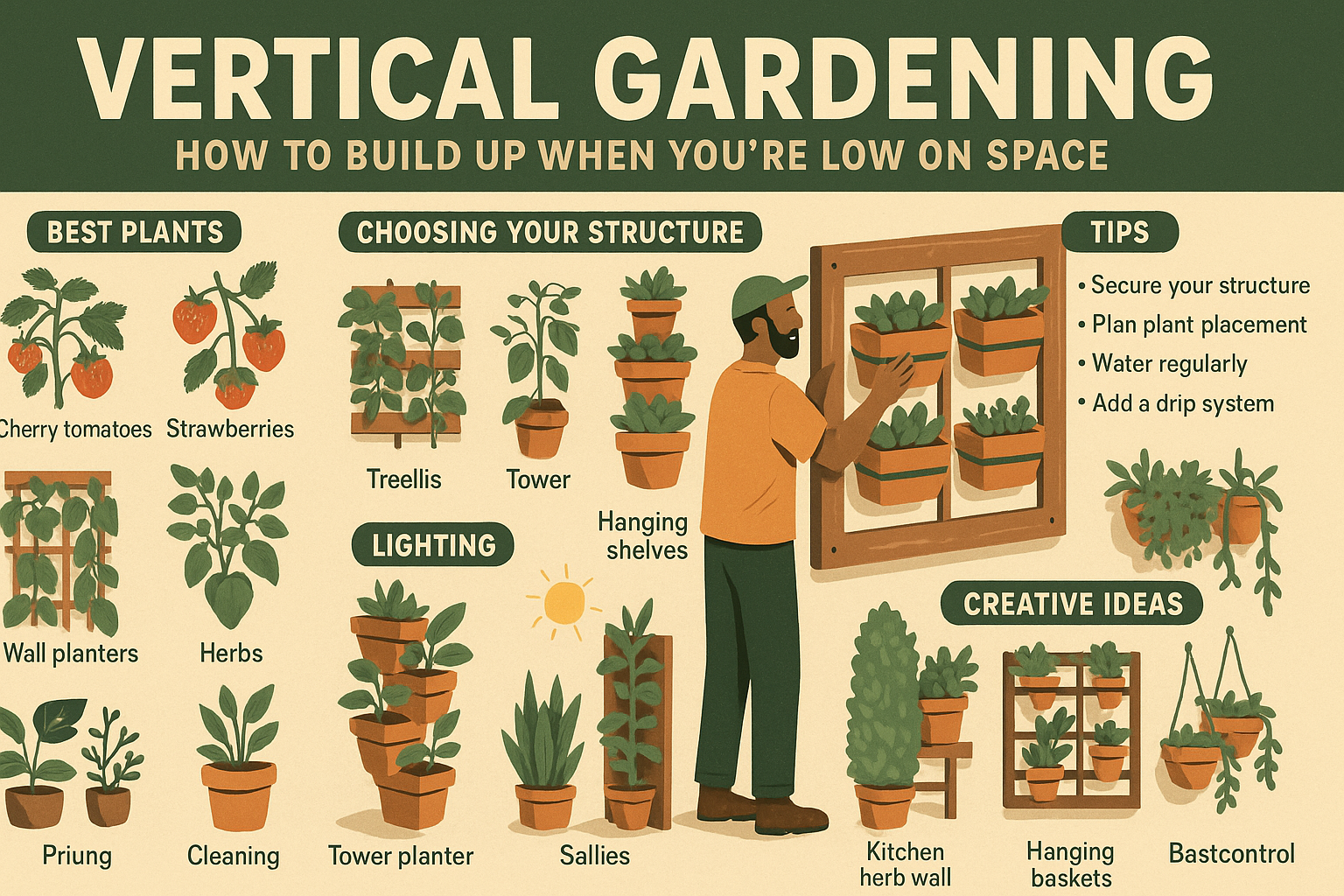Gardening doesn’t always require a large backyard. In fact, when you’re limited on horizontal space, the smartest move is to go vertical. Vertical gardening allows you to grow more in less space, adds aesthetic value, and can even improve plant health by boosting airflow and light exposure. Let’s explore how to build your own vertical garden—whether on a balcony, patio, or even indoors.
What Is Vertical Gardening?
Vertical gardening is the practice of growing plants upward rather than outward. It involves structures like walls, trellises, shelves, and hanging systems that allow plants to climb or cascade. This method is ideal for:
- Urban apartments and small patios
- People with limited mobility
- Creative landscape designs
- Maximizing sunlight in tight areas
It’s also a fun and innovative way to turn any wall or fence into a living piece of art.
Benefits of Vertical Gardening
- Space efficiency: Great for balconies, windows, or compact yards
- Improved air circulation: Reduces mildew and pests
- Easier maintenance: Less bending and fewer weeds
- Aesthetic appeal: Adds depth and texture to plain surfaces
- Increased yield: Grow more in the same footprint
It’s the perfect solution for city dwellers and renters alike.
Best Plants for Vertical Gardens
When building a vertical garden, select plants that naturally climb, trail, or stay compact:
Edible Plants
- Cherry tomatoes
- Strawberries
- Cucumbers (on trellis)
- Herbs like basil, thyme, and oregano
- Lettuce and spinach (in pockets or towers)
Flowers
- Nasturtiums
- Petunias
- Morning glories
- Begonias
- Marigolds
Indoor or Shade Plants
- Pothos
- Ferns
- Philodendron
- Spider plants
- Succulents
Mix and match according to sunlight, watering needs, and design.
Choosing Your Vertical Gardening Structure
There are several structure options based on your space and preferences:
1. Wall Planters
Mountable containers or fabric pockets for growing herbs, flowers, or leafy greens.
- Best for: Indoor or outdoor use
- Installation: Requires wall brackets or hooks
2. Trellises and Lattices
Support climbing plants like beans or cucumbers.
- Best for: Outdoor gardens or pots
- Material: Wood, metal, or plastic
3. Tower Planters
Stackable planters that form a column, perfect for strawberries or greens.
- Best for: Balconies and patios
- Tip: Choose rotating models for easy access
4. Hanging Baskets and Shelves
Use ropes, hooks, or ladder-style shelving for cascading plants.
- Best for: Decorative gardens and small patios
- Safety: Ensure strong support and drainage
5. DIY Options
Upcycle old pallets, shoe organizers, or plastic bottles.
- Budget-friendly
- Customizable and creative
Tips for Building Your Vertical Garden
- Secure your structure: Especially in windy areas
- Use lightweight soil mix: Reduces pressure on containers
- Plan plant placement: Put sun-loving plants at the top
- Water from the top: Let gravity help distribute moisture
- Add a drip system: For convenience and consistent hydration
Vertical gardens may dry out faster, so monitor soil moisture regularly.
Lighting and Sunlight Considerations
Vertical gardens should match the light conditions of your location:
- South-facing walls: Get full sun—great for vegetables
- East or west: Best for partial shade plants
- Indoors: Use LED grow lights for sufficient light levels
Rotate plants occasionally to ensure even exposure.
Maintenance and Care
- Watering: Use a watering can with a long spout or a drip line
- Fertilizing: Monthly feeding keeps plants vigorous
- Pruning: Regular trimming prevents overgrowth
- Cleaning: Remove dead leaves and debris weekly
- Pest control: Keep an eye out for aphids and mites, especially in tight areas
With a routine, your vertical garden will stay lush and productive.
Creative Ideas for Vertical Gardens
- Herb Wall in the Kitchen: Fresh seasonings at arm’s reach
- Balcony Fence Planters: Decorate railings with colorful blooms
- Living Room Plant Wall: Adds a natural touch to interiors
- Privacy Screen: Use tall structures with climbing vines
- Hanging Vegetable Garden: Tomatoes, peppers, and beans in pots
These ideas merge beauty and practicality for any space.
Conclusion: Grow Up, Not Out
Vertical gardening transforms even the tiniest of spaces into green havens. With the right plants and a bit of imagination, walls, corners, and fences become productive and beautiful. Whether you want a cozy herb wall or a cascading flower display, vertical gardening offers unlimited possibilities for growing up when space is tight.

